This homemade sunscreen is a great natural SPF option, with just 3 ingredients, plus you can make a waterproof version! Learn how to make sunscreen at home, so you control the ingredients, and spend a lot less for a high-quality natural sunscreen!
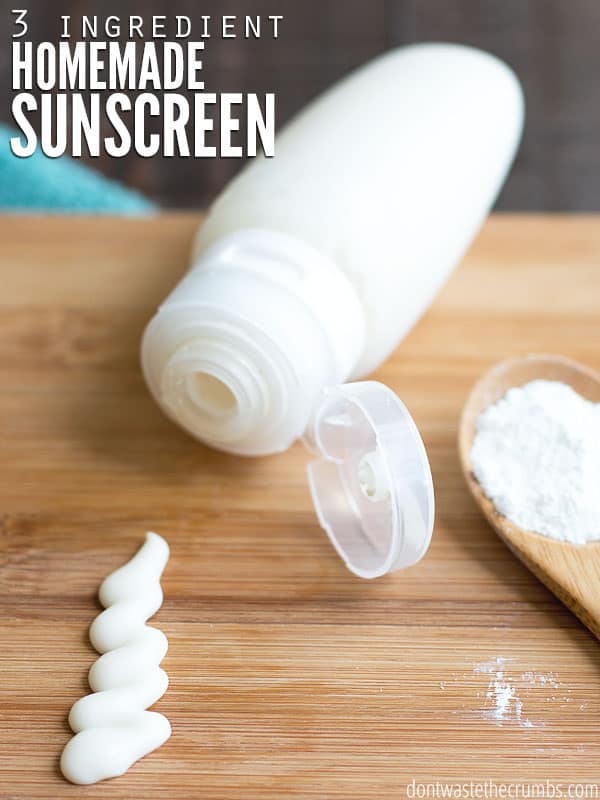
When we lived in California, we didn’t worry much about sunscreen and chose other methods for avoiding sunburns when we were outside for a long period of time.
Nowadays, between farm chores, hiking, and just enjoying the weather, we spend a lot more time outside getting sun exposure. But with 50% of the family having fair skin that’s prone to burning easily, I needed to find a sunscreen that worked! And of course, I wanted one that had a simple ingredients list and didn’t cost an arm and a leg.
After a bit of research, the clear winner was learning how to make sunscreen at home!
REASONS TO MAKE HOMEMADE SUNSCREEN
The more often we use a product or eat a food, the better quality I want it to be (I want natural products and simple, real food ingredients), and we’re finally to the point where it’s time to upgrade our sunscreen.
My two main reasons to make homemade sunscreen are the toxic ingredients in commercial sunscreens and the high cost of quality sunscreen.
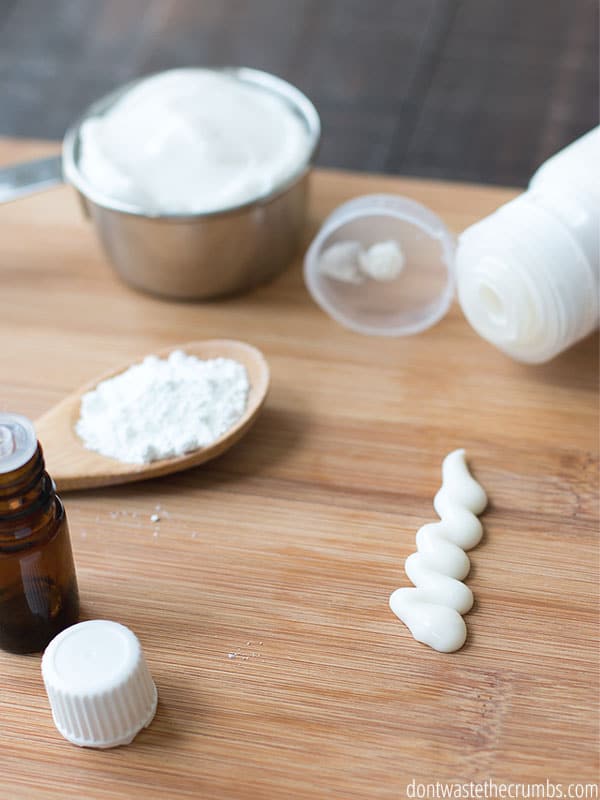
INGREDIENTS TO AVOID IN COMMERCIAL SUNSCREEN
Parabens
With the amount of sunscreen we use in the summer, our sunscreen needs to be free of toxins, and parabens are at the top of the list. According to the Environmental Working Group (EWG),
The concern with these chemicals is that scientific studies suggest that parabens can disrupt hormones in the body and harm fertility and reproductive organs, affect birth outcomes, and increase the risk of cancer. They can also cause skin irritation.
Vitamin A
A study conducted by the National Toxicology Program (NTP) found that a form of vitamin A, retinyl palmitate, may increase the development of cancerous skin tumors and lesions.
This ingredient is found in all sorts of make-up and skincare items because it has antioxidant properties that slow the aging of the skin. However, this same ingredient can also cause greater sensitivity to sunlight, according to the NTP. Not something I want in my sunscreen!
Fragrances
The Federal Drug Administration (FDA) doesn’t require the term “fragrance” to be broken down any further. Many companies hide their trade secrets behind this term on ingredient labels, and it might very well include something that is fragrant. But it can also include preservatives for the fragrance and other chemicals we have no way of knowing.
Because I don’t know what “fragrance” includes, I avoid it whenever possible.
COST OF HIGH-QUALITY SUNSCREEN
I’ve included some options for better quality sunscreens you can purchase at the end of this post, but the reality is that higher quality sunscreen from the store costs A LOT more than the lower-end stuff with the funky ingredients. Making your own homemade sunscreen can save you a ton of money, especially if you use it often!
PURE INGREDIENTS IN DIY SUNSCREEN
I’ve been trying homemade lotion recipes using various ingredients for a few years now and have been successful for Homemade Magnesium Lotion. However, for just plain lotion, my family hasn’t liked any of the batches.
So, it shouldn’t be a surprise that the homemade sunscreen recipes I tried that also use similar ingredients would create a texture that we wouldn’t like either:
- Some were way too thick.
- Others were sticky.
- Some smelled awful.
- Others wouldn’t rub in (at all).
- Some were too oily.
For one reason or another, every homemade sunscreen recipe I tried was a no-go.
However, one common thread I did find was that the homemade sunscreens with zinc oxide worked. And that’s what inspired me to create my own homemade sunscreen recipe with just 3 ingredients, using our favorite lotion as a base!
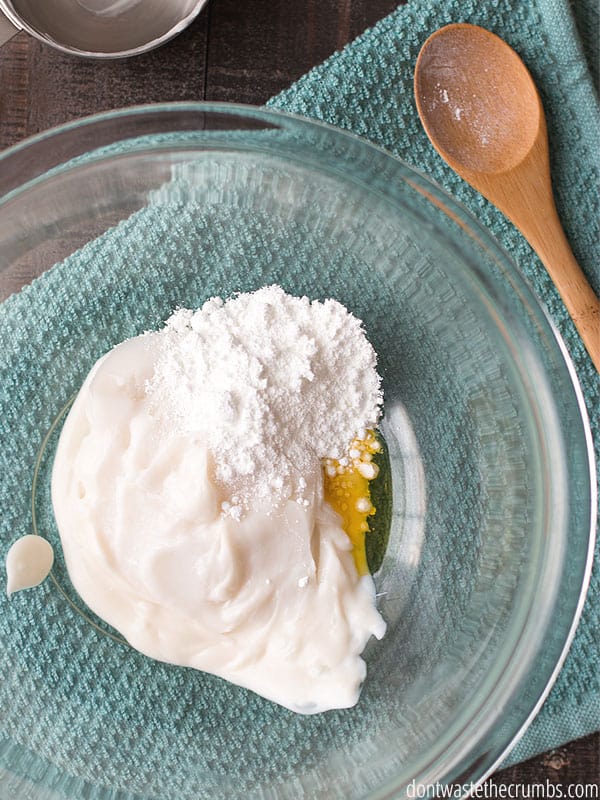
LOTION FOR DIY SUNSCREEN
As I mentioned, you want to avoid lotions that have parabens, synthetic Vitamin A, and fragrances. (Lotions that are scented naturally using essential oils and/or herbs are fine.)
My husband will confess to being a lotion snob, and for a long time, he only used one brand of lotion that DID have these ingredients. It took me YEARS to find a lotion that met his standards and didn’t have these awful ingredients.
For this DIY sunscreen, I’ve found that I prefer the lotion from Bend Soap Company.
TIPS FOR SUCCESSFUL HOMEMADE SUNSCREEN
Depending on the type of lotion you use, you might have to add other natural sunscreen ingredients to make it a bit more user-friendly as a sunscreen.
For example, my husband’s favorite lotion absorbs really quickly. This is fine as a lotion, but when I use it to make homemade sunscreen, it absorbs before I’ve had a chance to rub the sunscreen over the entire area. Adding 1-2 tablespoons of a carrier oil helps to thin the homemade sunscreen just a bit so I have extra time to rub it in.
Zinc oxide is famous for leaving a layer of white on the skin. Depending on how much zinc oxide powder you use, the layer might be thin and barely noticeable, or it might be thick and quite noticeable. You can tint homemade sunscreen though, to better match your skin. To do this, add cocoa powder ½ teaspoon at a time until you reach the desired color.
You can see the white sunscreen in the pictures above, and the tinted sunscreen after the instructions below. I used 1 teaspoon of cocoa powder in that batch and found it to be good for my fair skin.
HOW TO MAKE SUNSCREEN AT HOME
HOMEMADE SUNSCREEN SUPPLIES
- 4 oz of your favorite non-toxic lotion (I prefer the lotion from Bend Soap Company)
- 1 oz zinc oxide for about 20 SPF (2 Tbsp)
- 12 drops carrot seed oil (scant ¼ tsp)
Optional Ingredients (see “Tips for Successful Homemade Sunscreen” for how to use)
- 12 drops red raspberry seed oil
- 2 Tbsp jojoba oil or sweet almond oil or fractionated coconut oil
- 1-2 tsp cocoa powder
HOW TO MAKE SUNSCREEN
Step 1: Measure the lotion into a small bowl. Add the zinc oxide, oil(s), and any other optional ingredients as needed and mix well. Make sure not to inhale the zinc oxide.
Step 2: Store in glass mason jars or in a squeezable tube like this one. This recipe makes about ½ cup. Multiply as needed for larger batches.
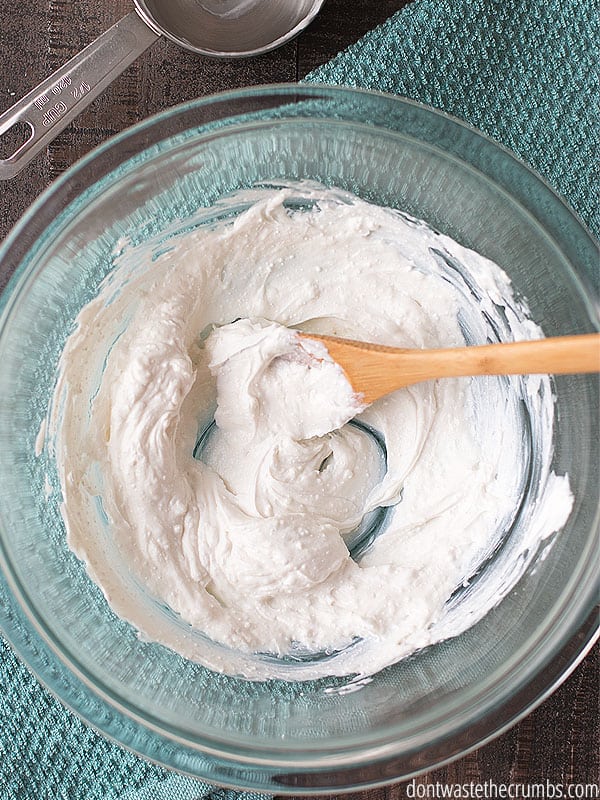
HOW TO MAKE SUNSCREEN AT HOME WATERPROOF
The DIY recipe above makes a sunscreen that rubs in easily and doesn’t feel greasy. I attribute this largely to using a lotion that we already like.
If you want to make a sunscreen that’s waterproof and will stand up to time spent in the pool, use the following waterproof DIY sunscreen recipe.
HOMEMADE WATERPROOF SUNSCREEN SUPPLIES
- 1 oz beeswax pellets (about 2 Tbsp)
- 4 oz of your favorite non-toxic lotion (I prefer the lotion from Bend Soap Company)
- 1 oz zinc oxide for about 20 SPF (2 Tbsp)
- 12 drops carrot seed oil (scant ¼ tsp)
Optional Ingredients (see “Tips for Successful Homemade Sunscreen” for how to use)
- 12 drops red raspberry seed oil** (scant ¼ tsp)
- 2 Tbsp jojoba oil or sweet almond oil
- ½-2 tsp cocoa powder
**If you don’t have carrot seed oil, raspberry seed oil has similar properties. Use the same amount as you would for carrot seed oil.
HOW TO MAKE SUNSCREEN WATERPROOF
Step 1: Make a double boiler by placing a glass or metal bowl over a pan of boiling water. Measure beeswax into the bowl and allow it to melt.
Step 2: Remove the melted wax from the heat and let it cool just slightly. Add the lotion and zinc oxide and stir until it’s completely incorporated. Make sure not to inhale the zinc oxide.
Step 3: Add the essential oils and any other optional ingredients as needed and stir well.
Step 4: Scoop into your storage container of choice. Although I really like using these squeezable tubes at the pool, homemade waterproof sunscreen is easier to clean out of glass jars.
Step 5: Allow to cool completely to room temperature before using.
Tip: Working with beeswax can be messy. Be sure to use bowls and spoons you won’t care to get dirty. For tips on how to clean beeswax and butter off your kitchen gear, read the tutorial on this post.
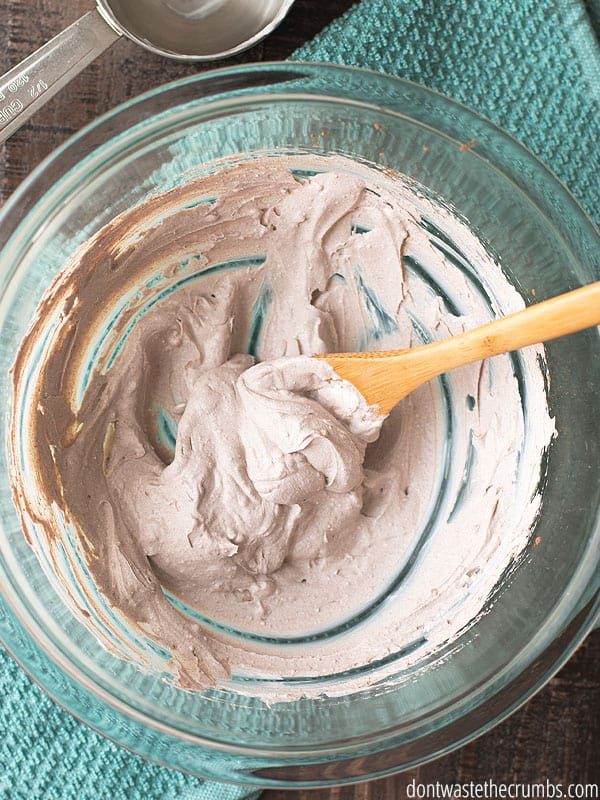
CONTROLLING THE SPF OF NATURAL HOMEMADE SUNSCREEN
My homemade sunscreen recipe relies on zinc oxide to provide your sun protection factor or SPF.
You can increase the amount of natural SPF you want in your homemade sunscreen by adding more zinc oxide, or by using less, in relation to the amount of lotion you’re starting with. Here’s a general chart for zinc oxide recommendations:
- For SPF 2-5: Use 5% zinc oxide
- SPF 6-11: Use 10% zinc oxide
- For SPF 12-19: Use 15% zinc oxide
- SPF 20+: Use 20% zinc oxide
If you wanted to make homemade sunscreen with an SPF of 20, you would calculate 20% of the amount of lotion you’re starting with. So, if you have 4 ounces of lotion, you would use 1 ounce of zinc oxide.
In theory, if you wanted to make homemade sunscreen SPF 50, you would use 50% zinc oxide. However, this would make a very thick, white paste that would be pretty impossible to spread (and of course, this isn’t FDA-approved or tested, but it’s a good estimate).
This is where a kitchen scale is very handy when making homemade sunscreen, although you can make do with measuring spoons if that’s what you have. One ounce is about the same as 2 tablespoons.
HOMEMADE SUNSCREEN FAQS
How long does homemade sunscreen last?
Because it does not have the preservatives that store-bought sunscreens do, homemade sunscreen will only last for a few months. Luckily, it’s easy to mix up another batch! We also recommend not leaving your DIY sunscreen in the car for the same reason. You’ll know it’s no longer good if it starts to develop an unpleasant smell.
Why is my homemade sunscreen clumpy?
The zinc oxide may not be fully incorporated into the homemade sunscreen. As you use it, those tiny white clumps should all rub into your skin. However, if the texture bothers you, you could try using a food processor or a blender to get them to break up and incorporate better.
What is the difference between carrot seed oil and carrot seed essential oil?
Carrot seed oil is a cold-pressed vegetable oil that can help with skin irritation and general skin nourishment. Carrot seed essential oil moisturizes and nourishes skin but needs to be diluted before applying to the skin.
BEST NATURAL SUNSCREENS TO BUY
I was overwhelmed at the mere thought of making homemade sunscreen for a long time. If that’s where you are, there’s nothing wrong with going store-bought.
I still buy sunscreen for the times we’re traveling or if I just don’t have time to make more! It’s easy to toss into the pool bag or pack on vacation.
Here are some mineral sunscreens recommended with simpler ingredient lists:
MORE SUMMER DIYS FOR NATURAL LIVING
- After Sun Spray
- Homemade Bug Spray (No Essential Oils)
- DIY Bug Repellent with Essential Oils
- Natural Home Remedy for Swimmer’s Ear
- DIY Citronella Candle
- DIY Homemade Shaving Cream
- Homemade Lotion Bar
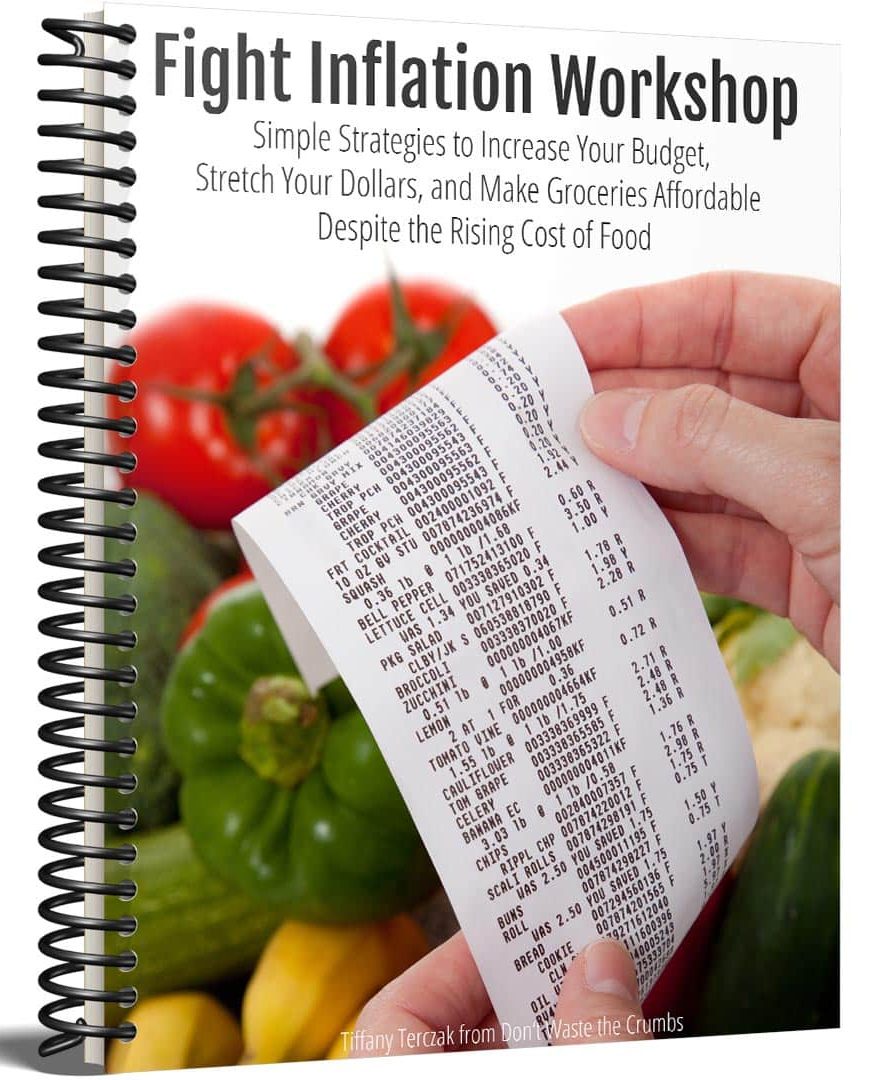

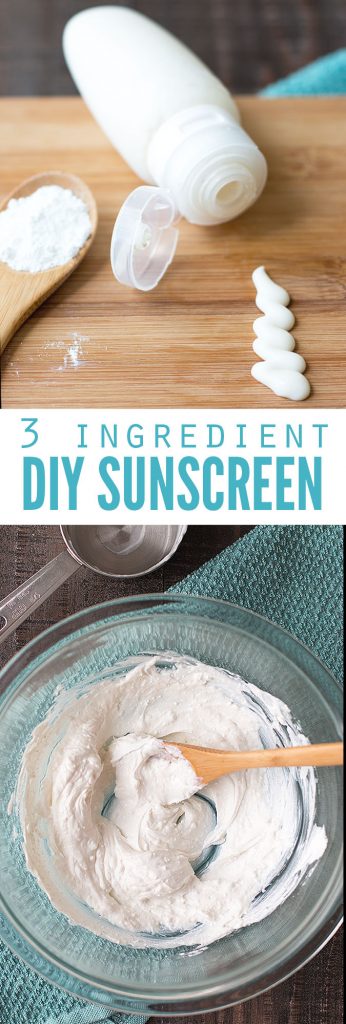


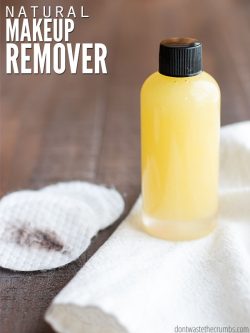


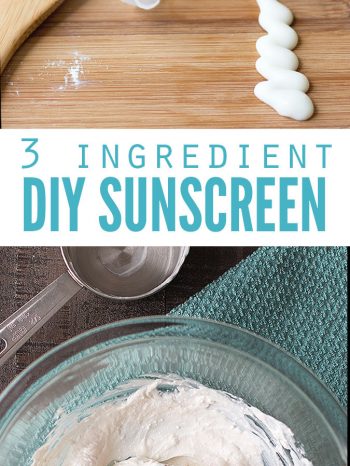
Was wondering on the cocoa powder. Is this powder what you would use for baking or is there a specific cocoa powder for natural makeup?
Hello Brenda,
For this Homemade Sunscreen, the cocoa powder that you use for baking is what is used. Hope this helps!
HELP! I just made some sunscreen with a smilar recipe I had found and it is WAAAY to runny. It called for Shea butter, coconut oil, carrot seed oil and zinc oxide. It was equal parts of the butter and the oil. Warmed up in a double boiler, then zinc added once it cooled. I now have a milky liquid, not lotion. Will this eventually thicken? I put some in the refrig just to see if that would help. Any ideas on how to thicken it if this doesn’t get any better? Thank you!
Hi Melissa! Chilling it may help since shea butter and coconut oil can liquify at warm temperatures. We did test our own recipe multiple times and it wasn’t runny.
Beeswax pellets that were melted hardened when mixed wit the lotion creating a bunch of hardened crud I had to sift out.
Please check below article, it mentions that neither carrot nor raspberry seed oils has SPF protection –
https://maslaskincare.com/blogs/beauty-and-wellness-journal/can-raspberry-and-carrot-seed-oils-really-protect-your-skin-from-the-sun#:~:text=Many%20sources%20claim%20that%20Raspberry,Seed%20Oil%20%2D%2030%2D40.
Hello Audra,
This post was written based on Tiffany’s own experience with raspberry and carrot seed oils. Your attached link is not from a definitive study of experts that raspberry seed oil/carrot do not have SPF properties. Tiffany did say in this post that carrot seed essential oil does not contain SPF properties. My best advice is that if you do not feel that these provide any SPF, then it is at your discretion whether you choose to use them or not. In Tiffany’s post, it is from her personal experience that these have worked for her and her family. Tiffany has always clarified that in her posts. Hope this helps.
Hi! Instead of using a favorite lotion, could I just get unrefined Shea butter, and blend it up really well, then add the other 2 ingredients? Thanks!
Hi Maribeth,
Sure you could do that. Let us know how it comes out. 🙂
I really appreciate this, thumbs up
I buy all my ingredients to make my Own homemade sunscreen thank you very for sharing this knowledge
Hi. This post was very informative for I’m trying to add SPF to my skincare products as a selling point.
I make handmade lotions. Have a few questions hoping you can possible help answer.
Does zinc oxide have to be included to get full SPF protection or would carrot/raspberry oil alone do the trick?
If zinc oxide doesn’t have to be included around what percentage of carrot/raspberry oil alone is required to get 30-50 SPF?
If zinc oxide is required what percentage is required to get 30-50% SPF
Hi Mickie,
As mentioned in the post, what I use is 20% zinc for 20+ SPF – and I add in the carrot seed oil just for the SPF properties the carrot see oil provides, but it doesn’t add SPF. So I cannot say that you will get 30-50 SPF if you use carrot seed oil and zinc. If you definitely need 30-50 SPF, I would recommend using a natural brand from a sunscreen manufacturer, to have a higher level of SPF to protect your skin. The homemade formula that I use in the post is for 20+ SPF with 20% zinc. Hope this helps!
Hi, Love your recipes; though more confused: how does carrot seed oil have SPF Properties, but doesn’t add SPF? and what’s the point? thank you
Hi Havad,
The carrot seed oil has a natural SPF ranging from 35-50. While this won’t add to the total SPF of the homemade sunscreen, Tiffany adds some because of its own natural SPF properties. As an added natural protective measure. If you don’t want to use carrot seed oil, you could just use zinc oxide to obtain your SPF. Hope this helps.
Thanks! I knew it could be better than constantly trying new sunscreens and my skin not agreeing with them.
I bought non-coated therapeutic grade zinc and mixed it with my fav facial lotion at a 1:4 ratio to make 20% spf. I also added a few drops of hemp seed oil since that agrees with my face, and it turned out great! I really had to mix it well, but any remaining tiny clumps came out when I rubbed it between my fingers to soften for application.
TIP: I found patting/dabbing it on instead of rubbing it works well once it softens between my fingers, to avoid irritation.
Hi I’m just wondering what the shelf life is for the sunscreen? Could I make a large batch for the whole summer? I have a beloved Ginger I would hate to burn! Also storage? Can I keep tube in the car?
Hi Kat,
Since this doesn’t have preservatives it will only last a couple months. We don’t recommend leaving it in the car for the same reason.
One final question. The batch is hardening up as it cools. Is that supposed to happen? Is there something I need to do differently when making it? Not sure how to easily spread it if it’s hard without warming it up every time. Thanks!
Can I make it with the healing lotion recipe you have?
Hi Tiffany,
Three questions: Mixing my first batch of the waterproof sunscreen now. I rubbed some in on my arm and there are little white flakes remaining all over. 1) Is there a way to remedy this? The lotion I chose is “Aveeno skin relief moisturizing.” 2) Is this one you’ve tried (the recipe says your husband likes Aveeno)? Also wanted to clarify with you. If I want to have 30 SPF, I would do 4oz lotion and then 1.2oz zinc oxide. 3) Is that right?
1 oz beeswax pellets (about 2 Tbsp)
4 oz of your favorite non-toxic lotion (I prefer the lotion from Bend Soap Company while my husband likes Aveeno)
1 oz zinc oxide for about 20 SPF (2 Tbsp)
12 drops carrot seed oil (scant ¼ tsp)
The Aveeno was mentioned because she was trying to get her husband AWAY from it since they have sooooo many carcinogen chemicals in their products. She has a few recommendations in the description above the listing for store bought chemical free lotion.
Hi! If I put the sunscreen in squeezable tubes and then refill it instead of trying to clean it out between uses, would that be ok? Is there an expiration for the sunscreen? Wouldn’t want to contaminate future batches. Thanks!
Hi Heidi,
We recommend cleaning it between uses since there aren’t preservatives. You don’t want any yucky bacteria to grow. 🙂
=l
All vitamin A products can skin phototoxicity, not just synthetic vitamin A. It’s a property of all alpha-hydroxyacids (AHAs), not just vitamin A. That includes: lactic acid, citric acid, and citrus juices/essential oils. Beta-carotene is the precursor to vitamin A. Carrot seed essential oil is more phototoxic than citrus essential oils and no essential oil is UV protective.
You should really only use carrot seed oil and raspberry essential oil on your skin at night and you really need to stop telling people they provide SPF. They do not, and you are increasing your risk of cancer by using them in sunscreen.
Hi Perry,
There’s a difference between carrot seed oil and carrot seed essential oil. Carrot seed oil provides SPF, but carrot seed essential oil does not. 🙂
I thought I wrote a comment, but I don’t see it now…
Can you tell me how much zinc oxide to lotion I would need to get an 65-70+ SPF?
Thank you.
Hi Eri! If you want SPF 65, you need your formula to be 65% zinc oxide. So if you’re making the recipe as-is (4 oz), you need 2.6 oz of zinc oxide. I’ll warn you – that is a lot. Your lotion will be very, very white and incredibly thick. I know you have your reasons, but just wanted to give you a heads up! (and of course this isn’t FDA approved or tested, but it’s a good estimate 😉 )
Hi there. Thank you for these recipes! Just wondering for the homemade sunscreen. Does the amount of zinc oxide need to increase to account for the addition of beeswax? Since there is now 5 ounces total of lotion and beeswax, should I increase the amount of zinc oxide to 1 oz to make it 20%? Thank you so much!
Hi Paulette! Ideally yes!
Please clarify for people that carrot seed oil is carrier oil not carrot seed essential oil.
Actually, carrot seed is an essential oil, NOT a carrier oil.
I have been using Carrot seed oil as a carrier oil.
I have just looked it up –
“Grape seed oil is lightweight, easily absorbed by the skin, and has a neutral scent. It’s a good carrier oil to use with essential oils to make body oils and massage oils.”
Carrot Seed oil is an essential oil
Tiffany thanks for sharing your sunscreen recipe.
Emma & Michael Doherty: 20% of 4ozis 0.8oz. Pls check again.
Keep up the good work Tiffany, God bless you
Hey Tiffany! Thanks for the awesome post. I am also curious about the carrot seed oil… you claim it has at least an SPF of 35… so technically is there any reason you wouldn’t be able to use just carrot seed oil? If not, can you explain why not. Also I’m going to have to agree with Emma on the math. You might want to check the ratios again, here’s a good calculator:
https://www.calculatorsoup.com/calculators/math/ratios.php
80/20 = 4/x
Solving for x, x would equal 1
Michael, your answer is correct for your formula but your formula is wrong. Also not sure where you’re getting the 80 from.
x=4×0.2 so x=0.8
Hope that clarifies it.
Does it matter whether the cocoa powder is sweetened or not?
Nope!
Are there any lotions available on Amazon that you would recommend? Thanks!!!
Hi Melissa! There may be lotions on Amazon that don’t have icky ingredients, but I don’t know of any brands off hand. I’m sorry!
Okay. Thanks!!!
Hello! I did not follow your recipe in making my own lotion. however, I used similar ingredients from a different recipe and it is way too thick. I want to he able to squirt it out of a bottle but it has hardened so much that it is proving to be difficult to get out. Any suggestions of making it more liquidy so I can squeeze it out? Here is the recipe if that helps.
1/4 cup coconut oil
1/4 cup almond oil
2 tbs zinc oxide powder
25 drops Raspberry seed oil
3 tbs shea butter
1 tsp vitamin e oil
2 tbs beeswax
Hi Judy,
You can warm the entire contents over heat of double boiler OR in simmering water. Squeeze out into jar. It’s hard to fix recipe without knowing type of coco oil (virgin vs. fractionated), but that’s my guess why it’s solid.
Hi!
I haven’t tried this recipe yet, but I’m wondering, how long does this keep?
Hello Brittany,
This homemade sunscreen should last for up about 6 months before it starts to lose its proctection from the sun.
I did not have success mixing this recipe. The zinc oxide did not incorporate fully, small clumps remain. Is there a special trick to getting it mixed in? Thanks.
Hi Ann! The small clumps didn’t bother us, but you could try using a food processor or a blender to get them to break up and incorporate better!
I just had the same problem and took your advice. I put it in my little ninja single cup smoothy blender and it came out smooth and creamy.
Awesome Ashley! Thanks for sharing 🙂
Dear Tiffany,
Thanku very much for this incredible year long r&d recipe.with so much ease.
Thanku again from all of us.
I had bought shea butter, natural beeswax, pure almond oil, raspberry seed oil, vitamin e oil to prepare home made lotion.
And will use ur formula of 20% zinc ( non nano).
Will share the product how it will be done.
God bless.😋
You’re very welcome Nitesh!